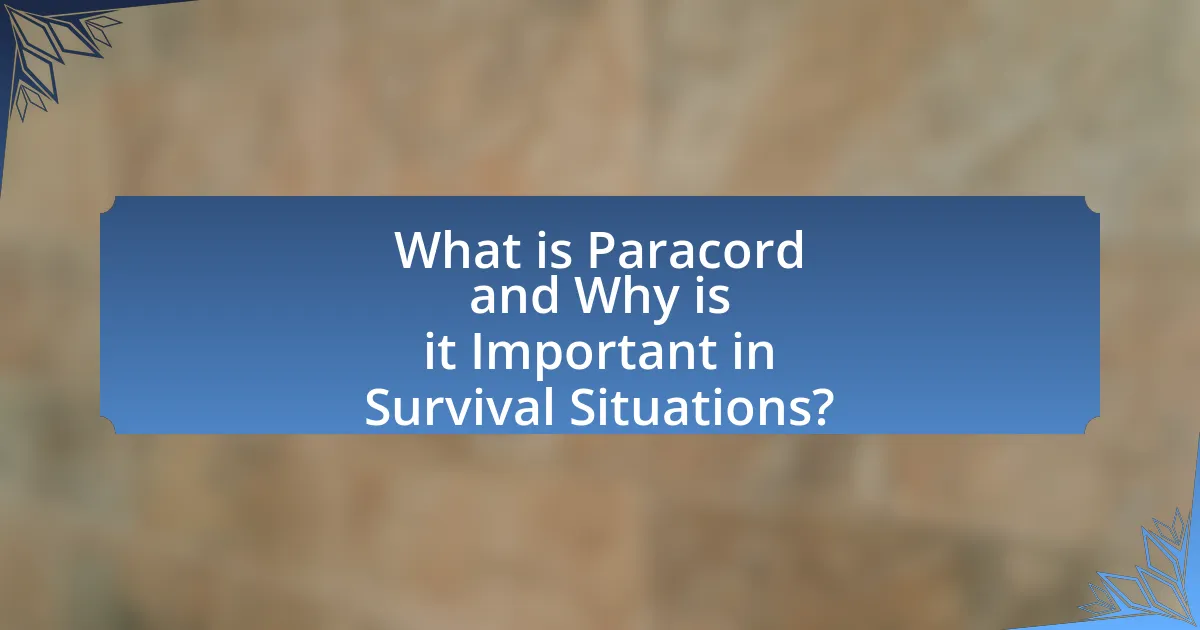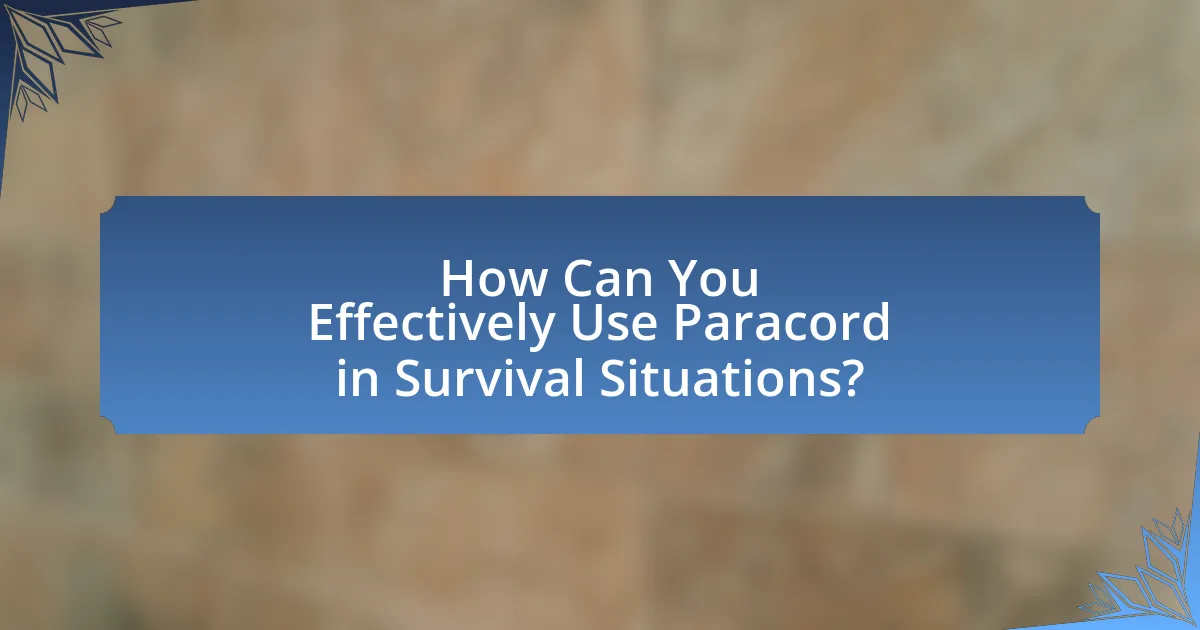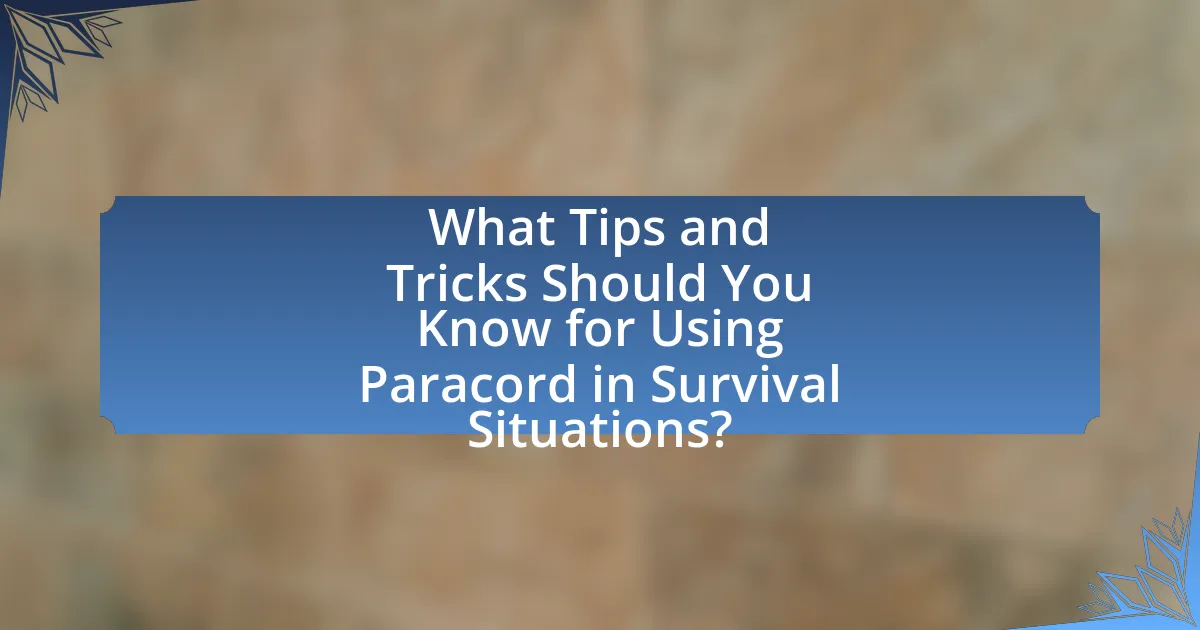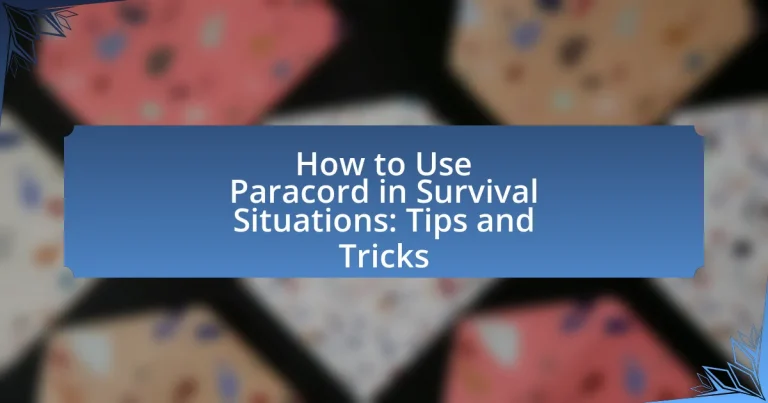Paracord, or parachute cord, is a lightweight nylon rope known for its high tensile strength and versatility, making it essential in survival situations. With a typical breaking strength of around 550 pounds, paracord can be utilized for various tasks such as building shelters, securing gear, and creating improvised tourniquets. The article explores the construction, types, and key features of paracord, along with practical applications in emergencies, including first aid and crafting survival gear. Additionally, it provides tips for effective use, storage, and knot-tying techniques to maximize paracord’s utility in critical scenarios.

What is Paracord and Why is it Important in Survival Situations?
Paracord, or parachute cord, is a lightweight nylon rope originally used in parachutes, known for its high tensile strength and versatility. In survival situations, paracord is crucial because it can be employed for various tasks such as building shelters, creating traps, securing gear, and making improvised tourniquets. Its strength, typically rated at around 550 pounds, allows it to withstand significant loads, making it reliable for emergency applications. Additionally, paracord can be unraveled to provide multiple strands for different uses, enhancing its utility in survival scenarios.
How is Paracord constructed and what are its key features?
Paracord is constructed from nylon, featuring a core of multiple inner strands encased in a durable outer sheath. This design allows paracord to be lightweight yet strong, with a typical tensile strength of around 550 pounds. Key features of paracord include its flexibility, resistance to abrasion, and ability to withstand various environmental conditions, making it suitable for a wide range of applications, from climbing to crafting survival gear. The inner strands can also be removed for use in emergency situations, adding to its versatility.
What materials are used in the making of Paracord?
Paracord is primarily made from nylon, which provides strength and durability. The nylon fibers are woven together to create a lightweight yet strong cord, typically with a tensile strength of around 550 pounds. This material choice is crucial for its applications in survival situations, as nylon is resistant to abrasion and UV light, enhancing its longevity and reliability in various environments.
How does the strength of Paracord compare to other types of rope?
Paracord has a tensile strength of approximately 550 pounds, making it stronger than many common types of rope, such as cotton or polypropylene ropes, which typically have lower tensile strengths. For instance, standard nylon rope can have a tensile strength ranging from 400 to 1,000 pounds depending on its diameter, but paracord’s versatility and lightweight nature make it particularly advantageous for survival situations. Additionally, paracord’s construction includes multiple inner strands, which can be utilized for various purposes, enhancing its overall utility compared to other ropes that may not offer such features.
What are the different types of Paracord available?
There are several types of paracord available, including Type I, Type II, Type III, Type IV, and Type V. Type I paracord has a minimum breaking strength of 95 pounds and is suitable for lightweight applications. Type II paracord has a breaking strength of 400 pounds, making it more versatile for various tasks. Type III paracord, also known as 550 paracord, has a breaking strength of 550 pounds and is the most commonly used type for survival situations due to its durability and flexibility. Type IV paracord has a breaking strength of 750 pounds, while Type V paracord can withstand up to 1,000 pounds, providing options for heavier-duty needs. These specifications confirm the varying strengths and applications of each type, making them suitable for different survival scenarios.
What are the characteristics of Type I, II, and III Paracord?
Type I, II, and III Paracord differ primarily in their strength and construction. Type I Paracord has a minimum breaking strength of 95 pounds and consists of a single nylon strand, making it suitable for lightweight applications. Type II Paracord has a minimum breaking strength of 400 pounds and typically contains 4 to 7 inner strands, providing more versatility for moderate tasks. Type III Paracord, also known as 550 Paracord, has a minimum breaking strength of 550 pounds and consists of 7 inner strands, making it the most robust option for heavy-duty use in survival situations. These specifications are standardized by the military and widely recognized in outdoor and survival communities.
How do specialized Paracord types differ from standard options?
Specialized Paracord types differ from standard options primarily in their construction, strength, and intended use. While standard Paracord typically consists of a nylon sheath with seven inner strands, specialized types may incorporate additional materials or unique designs to enhance specific properties, such as increased tensile strength, UV resistance, or water resistance. For example, Mil-Spec Paracord meets military specifications for durability and load-bearing capacity, often exceeding the standard 550-pound strength of regular Paracord. Additionally, types like reflective Paracord include reflective fibers for visibility in low-light conditions, making them more suitable for survival situations where safety is a concern.
Why is Paracord considered a versatile tool in survival scenarios?
Paracord is considered a versatile tool in survival scenarios due to its high tensile strength, lightweight nature, and multiple applications. With a breaking strength of approximately 550 pounds, paracord can be used for tasks such as securing gear, building shelters, and creating traps. Its inner strands can be extracted for fishing line or sewing thread, enhancing its utility in various survival situations. Additionally, paracord is resistant to mildew and abrasion, making it suitable for outdoor use in diverse environments.
What are the primary uses of Paracord in survival situations?
Paracord is primarily used in survival situations for its versatility in various applications such as building shelters, creating traps, securing gear, and making emergency repairs. Its strength, typically rated at 550 pounds, allows it to be employed for tasks like constructing a makeshift tent or hammock, which can provide essential protection from the elements. Additionally, paracord can be unraveled to produce smaller strands for fishing lines or sewing materials, enhancing its utility in survival scenarios. The ability to withstand harsh conditions and its lightweight nature make paracord an indispensable tool for outdoor enthusiasts and survivalists alike.
How can Paracord be used for shelter building and securing gear?
Paracord can be used for shelter building by creating tension lines and securing tarps or other materials to form a protective structure. This versatile cord, with a tensile strength of approximately 550 pounds, allows for the construction of various shelter types, such as A-frame or lean-to designs, by anchoring the corners and securing the sides effectively. Additionally, paracord is useful for securing gear by tying down equipment to prevent movement during transport or while in use, ensuring that essential items remain organized and accessible. Its lightweight and durable nature makes it an ideal choice for both shelter construction and gear management in survival situations.

How Can You Effectively Use Paracord in Survival Situations?
Paracord can be effectively used in survival situations for a variety of essential tasks, including building shelters, creating traps, and securing gear. Its high tensile strength, typically around 550 pounds, makes it suitable for applications such as constructing a makeshift shelter by tying branches together or securing tarps. Additionally, paracord can be unraveled to provide smaller strands for fishing lines or sewing materials, enhancing its versatility in survival scenarios. The ability to withstand harsh conditions further validates its effectiveness, as paracord is resistant to mildew and UV damage, ensuring reliability in outdoor environments.
What are some essential knots to know when using Paracord?
Essential knots to know when using Paracord include the Bowline Knot, which creates a fixed loop at the end of a rope; the Square Knot, used for joining two lengths of rope; and the Clove Hitch, ideal for securing a rope to a post or tree. The Bowline Knot is particularly valuable in survival situations because it does not slip under load, making it reliable for rescue scenarios. The Square Knot is effective for tying packages or bundles securely, while the Clove Hitch allows for quick adjustments and is easy to untie after use. These knots are fundamental for various applications in survival, ensuring safety and efficiency.
How do you tie a Bowline knot and when should you use it?
To tie a Bowline knot, create a small loop in the standing part of the rope, pass the working end through the loop from underneath, wrap it around the standing part, and then bring it back down through the loop. The Bowline knot is used when a fixed loop is needed at the end of a rope, making it ideal for rescue situations, securing items, or mooring boats, as it does not slip or bind under load.
What is the purpose of a Clove Hitch and how is it tied?
A Clove Hitch is primarily used to secure a rope to a post or object, providing a reliable hold that can be easily adjusted or released. To tie a Clove Hitch, wrap the rope around the object twice, crossing the working end over the standing part of the rope on the second wrap, and then tuck the working end under the last wrap. This knot is effective in various survival situations, such as securing tents or gear, due to its simplicity and ease of adjustment.
How can Paracord be utilized for first aid in emergencies?
Paracord can be utilized for first aid in emergencies by serving as a makeshift tourniquet, securing splints, or creating slings. In situations where severe bleeding occurs, paracord can be tightly wrapped around a limb to restrict blood flow, effectively acting as a tourniquet. Additionally, paracord can be used to immobilize fractures by securing splints made from available materials, providing necessary support. For injuries requiring arm support, paracord can be fashioned into a sling to alleviate pressure and stabilize the injured area. These applications are supported by the versatility and strength of paracord, which can withstand significant tension, making it a reliable tool in emergency first aid scenarios.
What techniques can be employed to create splints or slings with Paracord?
Techniques to create splints or slings with Paracord include the use of a simple knotting method, such as the bowline knot, to secure the splint material, and the construction of a sling using a lark’s head knot to attach the Paracord to a sturdy support. The bowline knot provides a fixed loop that can hold splint materials like sticks or rolled-up fabric securely in place, while the lark’s head knot allows for easy adjustment and attachment to the injured area. These techniques are effective because they utilize the strength and flexibility of Paracord, which can support significant weight and withstand tension, making them reliable for emergency situations.
How can Paracord assist in securing a makeshift tourniquet?
Paracord can assist in securing a makeshift tourniquet by providing a strong, durable, and flexible material that can effectively apply pressure to a wound. Its tensile strength, typically around 550 pounds, allows it to withstand significant force without breaking, making it ideal for constricting blood flow in emergency situations. Additionally, paracord’s lightweight nature and compact size make it easy to carry and deploy quickly when needed, ensuring that it can be used effectively in critical moments.
What are some creative uses of Paracord beyond traditional applications?
Paracord can be creatively used for various applications beyond its traditional uses, such as crafting jewelry, creating keychains, and making dog leashes. These applications leverage paracord’s durability and versatility, allowing individuals to design functional and aesthetic items. For instance, paracord bracelets can be unraveled in emergencies to provide strong cordage, while custom keychains can serve as a practical accessory that also showcases personal style. Additionally, paracord dog leashes combine strength with comfort, making them suitable for pet owners who require reliable gear.
How can Paracord be transformed into fishing lines or traps?
Paracord can be transformed into fishing lines or traps by utilizing its strong tensile strength and flexibility. To create fishing lines, one can unravel the inner strands of paracord, which are thin yet durable, and use them as fishing line due to their ability to withstand significant weight. For traps, paracord can be fashioned into snares or fishing nets by tying knots and creating loops that can capture fish or small game. The effectiveness of paracord in these applications is supported by its breaking strength of approximately 550 pounds, making it a reliable choice for survival situations.
What are the benefits of using Paracord for crafting survival gear?
Paracord offers numerous benefits for crafting survival gear, primarily due to its strength, versatility, and lightweight nature. Specifically, paracord can support loads of up to 550 pounds, making it ideal for applications such as securing gear, building shelters, and creating emergency harnesses. Additionally, its flexibility allows for various uses, including fishing lines, tourniquets, and fire-starting tools, enhancing survival capabilities in critical situations. The material is also resistant to mildew and UV light, ensuring durability in diverse environmental conditions. These characteristics make paracord an essential component in survival gear crafting.

What Tips and Tricks Should You Know for Using Paracord in Survival Situations?
To effectively use paracord in survival situations, one should know its versatility and strength. Paracord can be utilized for various purposes, including building shelters, creating traps, and securing gear. For instance, a common technique is to use paracord to construct a makeshift shelter by tying it between trees to support a tarp or poncho. Additionally, paracord can be unraveled to access the inner strands, which can serve as fishing line, sewing thread, or emergency tourniquets. The tensile strength of standard paracord is approximately 550 pounds, making it reliable for heavy-duty tasks. Furthermore, learning knots such as the bowline or clove hitch enhances its utility in securing items or creating loops. These practical applications demonstrate paracord’s essential role in survival scenarios.
How can you prepare and store Paracord for easy access in emergencies?
To prepare and store Paracord for easy access in emergencies, first, cut the Paracord to a manageable length, typically between 50 to 100 feet, depending on your needs. Next, coil the Paracord neatly and secure it with a rubber band or Velcro strap to prevent tangling. Store the coiled Paracord in a waterproof bag or container to protect it from moisture and environmental damage. Additionally, keep the stored Paracord in a readily accessible location, such as a survival kit or emergency backpack, ensuring it is easy to retrieve when needed. This method allows for quick deployment and maintains the integrity of the Paracord for various survival applications.
What are the best practices for coiling and storing Paracord?
The best practices for coiling and storing Paracord include using a figure-eight coil method and keeping it in a dry, cool place. The figure-eight coil prevents tangling and allows for easy uncoiling when needed. Storing Paracord in a moisture-resistant container or bag protects it from environmental damage, ensuring its longevity and reliability. Proper storage conditions, such as avoiding direct sunlight and extreme temperatures, further enhance the durability of the Paracord.
How can you ensure your Paracord remains in good condition over time?
To ensure your Paracord remains in good condition over time, store it in a cool, dry place away from direct sunlight and moisture. Exposure to UV light can degrade the nylon fibers, while humidity can lead to mold and mildew. Regularly inspect the Paracord for signs of wear, such as fraying or discoloration, and clean it gently with mild soap and water if it becomes dirty. Proper maintenance, including avoiding excessive tension and sharp edges during use, will also prolong its lifespan. These practices are supported by the material properties of nylon, which is known for its durability but can deteriorate under adverse conditions.
What common mistakes should you avoid when using Paracord?
Common mistakes to avoid when using Paracord include not understanding its load capacity, failing to inspect for damage before use, and using inappropriate knots. Paracord has a typical tensile strength of around 550 pounds, and exceeding this limit can lead to failure during critical situations. Additionally, using frayed or worn Paracord can compromise safety, as it may not hold under stress. Lastly, employing the wrong type of knot can result in slippage or failure; for example, using a square knot for load-bearing applications is not advisable, as it is not secure under heavy tension.
How can improper knot tying affect the effectiveness of Paracord?
Improper knot tying significantly reduces the effectiveness of Paracord by compromising its strength and reliability. When knots are not tied correctly, they can slip or come undone under tension, leading to potential failures in critical situations such as securing gear or creating shelters. For instance, a poorly tied bowline knot can lose its integrity, resulting in a load-bearing failure, which is particularly dangerous in survival scenarios where safety is paramount. Studies show that knots can lose up to 50% of their strength when tied incorrectly, emphasizing the importance of proper knot techniques in maximizing Paracord’s utility.
What should you be cautious about when using Paracord in extreme conditions?
When using Paracord in extreme conditions, you should be cautious about its strength limitations and susceptibility to environmental factors. Paracord typically has a tensile strength of around 550 pounds, but this can be compromised by factors such as UV exposure, moisture, and extreme temperatures, which can weaken the fibers over time. For instance, prolonged exposure to sunlight can degrade the nylon material, reducing its effectiveness. Additionally, in wet conditions, Paracord can absorb water, leading to increased weight and potential loss of strength. Therefore, understanding these limitations is crucial for ensuring safety and reliability in survival situations.
What are some practical scenarios where Paracord can be a lifesaver?
Paracord can be a lifesaver in various practical scenarios, including emergency shelter construction, securing gear, and creating makeshift tourniquets. In survival situations, individuals can use paracord to build a shelter by tying branches together, providing protection from the elements. Additionally, paracord is effective for securing equipment to backpacks or vehicles, preventing loss during travel. In medical emergencies, paracord can be fashioned into a tourniquet to control severe bleeding, demonstrating its versatility and critical role in survival situations.
How can Paracord assist in emergency signaling or rescue situations?
Paracord can assist in emergency signaling or rescue situations by being used to create visible signals or markers. Its bright colors can be utilized to make distress signals that are easily seen from a distance, enhancing visibility for rescuers. Additionally, paracord can be fashioned into various shapes, such as flags or arrows, to direct attention to a specific location. The versatility of paracord allows it to be tied to trees or other structures, effectively marking a spot for search and rescue teams.
What are the best ways to integrate Paracord into your survival kit?
The best ways to integrate Paracord into your survival kit include using it for shelter construction, securing gear, and creating emergency tools. Paracord’s strength, typically rated at 550 pounds, makes it ideal for building shelters by tying down tarps or securing branches. Additionally, it can be used to secure equipment, preventing loss during movement. Paracord can also be unraveled to create fishing lines, snares, or even tourniquets, enhancing its utility in survival scenarios. These applications are supported by its versatility and durability, making Paracord an essential component of any survival kit.


